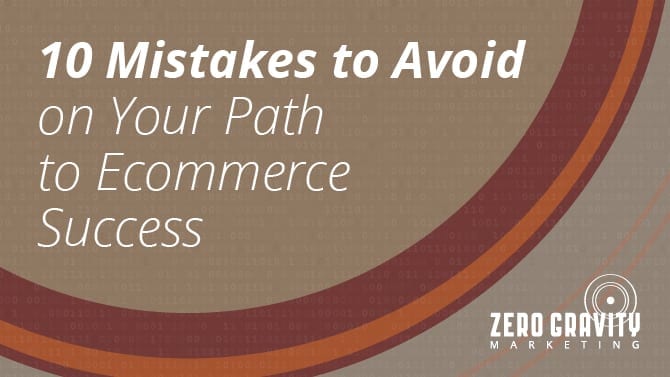Ecommerce looks easy, but it can be challenging to achieve the kind of success you envision for your business. Based on our experience helping clients deal with ecommerce issues over the years, here are 10 common mistakes that can block your path to ecommerce success.
- Pricing products based on their brick and mortar price points– If you have a retail store, especially a high-end one, it’s not a good idea to match your online and in-store prices. Online shoppers typically compare prices and seek the best deals. If they are willing to travel to a physical store, they may be open to paying more.
- Charging premium prices for commodity products– The Internet is good at turning products into commodities. What you might think is a special, premium product, may look like a commodity in ecommerce. For example, let’s say you sell high quality woodworking tools. You know your products are the best and you charge a premium for them. However, for many online buyers, your products may simply resemble overpriced versions of tools available at a fraction of the cost on Homedepot.com or Walmart.com. If your products are not priced competitively, you will have a very poor conversion rate. Alternatively, you will have to invest effort into making a case for why your products are better, e.g. through customer testimonials.
- Not differentiating enough– Selling the identical products as others is tricky. Even if you’re pricing them competitively, you may still run into some ecommerce issues. Shoppers usually choose to buy from larger, better-known online retailers. Amazon, for instance, makes it especially easy to check out and if you have Prime, shipping is free and FAST.
- Not understanding shopper buying behavior– Some products just don’t sell well via ecommerce and there’s usually a reason for it. It could be as simple as inertia and complacency. However, shoppers are often smarter than we realize. It might seem intuitive to sell paper towels online, but in reality, people usually run out and buy paper towels when they need them. They need them right away and don’t want to deal with online shopping hassles. There are some amazing exceptions, of course, like Dollar Shave Club, but it pays to understand how they created value in a specific category.
- Misjudging the appeal of a subscription model– Subscriptions work for products that are suited to subscriptions. That may sound obvious, but we have seen many companies create needless ecommerce issues for themselves by offering subscriptions for products that don’t run out and need regular replacement. If you sell homemade granola, for example, unless your buyers are absolutely addicted to it, they will resist signing up for a recurring shipment of the stuff.
- Being vulnerable to wholesalers undercutting MAP pricing– This applies to manufacturers. If you sell your products wholesale to “retailers,” some of them may then resell your stuff on Amazon or Ebay at lower than Manufacturers Advertised Pricing (MAP) pricing. You have to investigate these practices and penalize fake retailers who are breaking the rules. You can do this by tracking your products’ GTIN numbers.
- Mis-pricing shipping– Shipping is a key ingredient of ecommerce success. People don’t like to pay for shipping these days. If the shipping price is too high, they may look for an alternative.
- Underestimating the challenge of selling a new product or concept– If you’ve invented a new product for which there is no category, you may be on the edge of a huge influx of buyers, but you need to test the market and create demand. You’ll need to generate awareness and perhaps educate the target audience on the uses and benefits of your product.
- Being overconfident in the launch of an unknown brand– This is similar to the ecommerce issues that arise with a new product, but it’s an even deeper challenge. You’re starting at zero, with a big job of raising awareness and building trust in your brand before people will start to buy from you.
- Expecting customers to buy from a website that’s hard to use –If your website is not easy to find and navigate, or if it’s difficult to check out, these usability problems will affect your sales conversion rates.
As the mistakes reveal, ecommerce success is about mastering supply and demand. That sounds simple, but it can take some thoughtful analysis to resolve the inevitable ecommerce issues that arise.
To learn how we can help you achieve ecommerce success, visit us at www.zerogravitymarketing.com.








